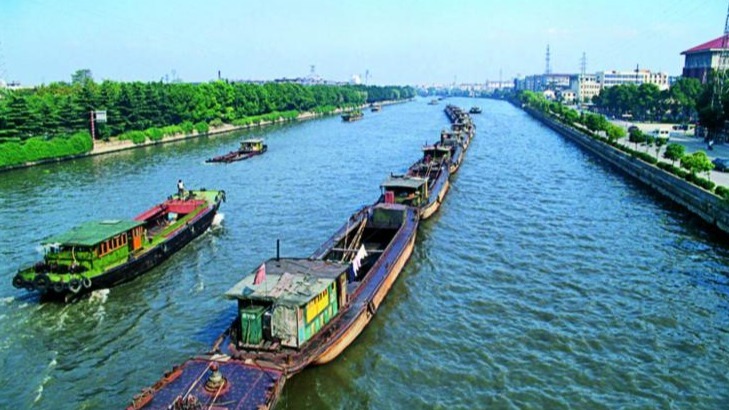As a flowing cultural heritage, the Grand Canal, with a history of 2,500 years, is the longest and largest canal in the world. Doing a good job in the protection, inheritance and utilization of the cultural heritage of the Grand Canal is of great significance to our profound understanding of the excellent traditional Chinese culture, firming up cultural self-confidence, condensing the national spirit, passing on human civilization and promoting high-quality development.
The prosperity of the Canal still exists, and its historical flavor is long and brilliant. A large number of historical relics and monuments are distributed along the Grand Canal, such as ancient bridges, ancient wharves, ancient buildings, ancient locks and ancient villages. These heritages not only reflect the superior skills of ancient Chinese water conservancy and architectural engineering, but also the historical changes and social culture of the areas along the route. However, with the elapse of time and the acceleration of modernization, the protection of the Grand Canal is facing multifaceted challenges. On the basis of respecting and protecting cultural heritage, scientifically plan the development and utilization of the Grand Canal and its coastal areas, and prevent unreasonable development activities from destroying cultural heritage; scientifically restore and regularly maintain important cultural relics such as ancient bridges and locks, so as to maintain their historical appearance and cultural value; actively participate in international exchanges and cooperation on cultural heritage protection, learn advanced international protection concepts and technologies, and jointly promote the protection of the cultural heritage of the Grand Canal.
The beauty of the canal lies in its water quality. While effectively protecting the tangible cultural heritage, it is also necessary to do a good job of ecological environmental protection of the Grand Canal: through the establishment of a more stringent water quality monitoring system, timely detect and dispose the sources of pollution; to enhance the treatment capacity of sewage treatment plants, and strictly prohibit the direct discharge of untreated sewage; restore the vegetation along the river banks through the ecological restoration project, rebuild the aquatic habitat, and accelerate the restoration of biodiversity; and to guide the farmers to reduce the use of fertilizers and pesticides, and promote ecological agriculture to reduce the pollution of water bodies. The canal will become a flowing, environmentally friendly, clean and safe ecological corridor through the series of initiatives.
Craftsmanship has been passed on through intangible cultural heritage. Along the Grand Canal, in addition to those specific historical buildings and artifacts, the intangible cultural heritage of the Grand Canal is equally rich in connotations, including craftsmanship and ethnic customs. High-quality promotion of the utilization of the intangible cultural heritage of the Grand Canal requires digging up the traditional skills along the route through in-depth investigation and research, compiling a series of books and materials, and providing rich teaching materials for subsequent learning and inheritance; a series of cultural activities, such as exhibitions of intangible cultural heritage and demonstrations of traditional skills, can be organized to introduce these traditional cultures into daily life and promote their dissemination in the society; emphasis should be placed on the cultivation and support for the inheritors of the intangible cultural heritage, including the provision of technical training, financial support for living and creation, and the establishment of platforms for display and exchange; inheritance of the intangible cultural heritage should be incorporated into school education curricula to foster more young people interested in traditional culture, so as to revitalize these traditional cultures; and attention should be paid to the innovative inheritance and integrative development of intangible cultural heritage, including the combination of traditional culture with modern lifestyles, and the exploration of new forms of expression and means of transmission.
A key objective of preserving the cultural heritage of the Grand Canal is to innovate the wisdom of the past and turn it into a participatory force in the modernization of the present. We hope to continue to strengthen the planning and construction of the Grand Canal Cultural Belt, protect, excavate and interpret the excellent traditional culture carried by the Grand Canal, promote the integration of the Grand Canal culture with the elements of the times, and focus on the creation of a radiant cultural belt, a green ecological belt and a colorful tourism belt for the Grand Canal. The public can directly visualize the historical charm of the Grand Canal by developing cultural tourism projects themed on the Grand Canal. Hebei Province's promotion of the integration of culture and tourism by making the Langfang Xianghe section of the Grand Canal and the central city section of Cangzhou navigable for tourism is a good example, which has brought back the grand scenes of the past and attracted thousands of tourists. We can also combine the cultural elements of the Grand Canal and develop related cultural and creative products, such as books, souvenirs and art works, to expand the influence of the Grand Canal culture and tell the story of the Grand Canal.
